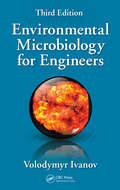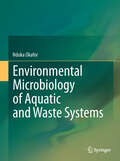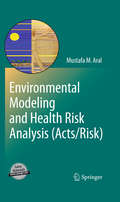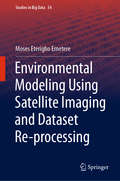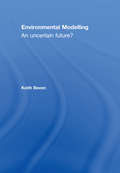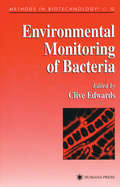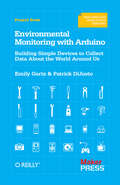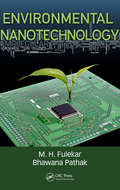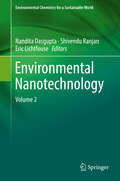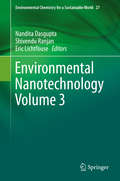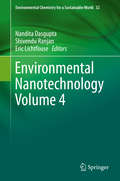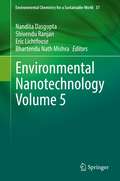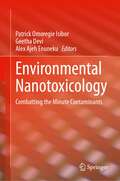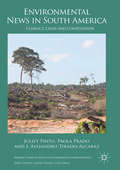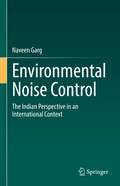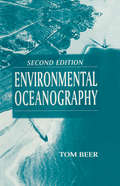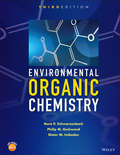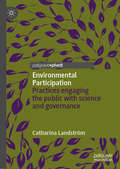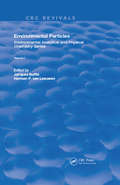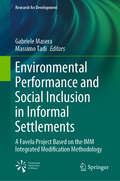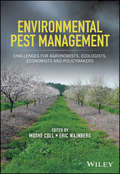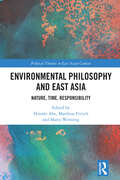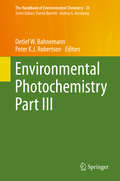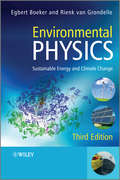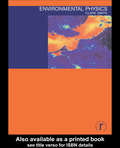- Table View
- List View
Environmental Microbiology for Engineers
by Volodymyr IvanovThe third edition of Environmental Microbiology for Engineers explores the role that microorganisms play in the engineered protection and enhancement of an environment. Offering a perfect balance of microbiological knowledge and environmental biotechnology principles, it provides a practical understanding of microorganisms and their functions in the environment and in environmental engineering systems. The book also presents a quantitative description of applied microbiological processes and their engineering design. This updated edition includes all new information on construction biotechnology, biogeotechnical engineering, construction biomaterials, environmental engineering of life-support closed ecosystems, defense biotechnologies, and biosafety in civil and environmental engineering. Features: Classroom tested in universities as a primary course text for civil and environmental engineering students Includes quizzes, problems, and solutions for better understanding of the material Covers essential topics such as the diversity and functions of microorganisms in the environment and environmental engineering systems, the structure and functions of microbial ecosystems, applied microbial genetics and molecular biology, environmental bioengineering, and more Offers combined coverage of microbiology and biotechnology adapted for students in advanced civil and environmental engineering courses Environmental Microbiology for Engineers provides a practical understanding of microorganisms in civil engineering processes and their functions in environmental engineering systems. It is intended for upper-level undergraduate, graduate, and post-graduate students of civil and environmental engineering. It is also useful for practicing environmental engineers working in the areas of wastewater, solid waste treatment, soil remediation, and ground improvement.
Environmental Microbiology of Aquatic and Waste Systems
by Nduka OkaforThis book places the main actors in environmental microbiology, namely the microorganisms, on center stage. Using the modern approach of 16S ribosomal RNA, the book looks at the taxonomy of marine and freshwater bacteria, fungi, protozoa, algae, viruses, and the smaller aquatic animals such as nematodes and rotifers, as well as at the study of unculturable aquatic microorganisms (metagenomics). The peculiarities of water as an environment for microbial growth, and the influence of aquatic microorganisms on global climate and global recycling of nitrogen and sulphur are also examined. The pollution of water is explored in the context of self-purification of natural waters. Modern municipal water purification and disease transmission through water are discussed. Alternative methods for solid waste disposal are related to the economic capability of a society. Viruses are given special attention. By focusing on the basics, this primer will appeal across a wide range of disciplines.
Environmental Modeling and Health Risk Analysis (Acts/Risk)
by Mustafa M. AralThis book is intended to serve as a comprehensive source for the advancements and contributions made in environmental transformation and transport modeling in general and the associated health risk assessment topics in particular. The selection of the title, "Environmental Modeling and Health Risk Analysis" stems from an ambitious objective of providing a review of air, surface water and groundwater quality modeling topics and linking these models with exposure and health risk analysis. Thus, the purpose is to provide the reader with an integrated perspective on these two seemingly distant fields. The ACTS and RISK software that is an integral part of this book include computational platforms for all models discussed in the book. Using these two software tools, available from http://extras.springer.com/ , the models described in the book can be readily accessed and used in classroom or professional applications as demonstrated in the book.
Environmental Modeling Using Satellite Imaging and Dataset Re-processing (Studies in Big Data #54)
by Moses Eterigho EmetereThis book introduces methods of re-processing images to extract numerical information that can be used to quantify the observables in environmental modelling. Experiments or procedures that yield large images can be statistically or parametrically examined. Through the use of open source libraries, the book shows how ‘big data’ in the form of images or datasets can be comparatively analysed along same defined procedures or standards. This book helps to solve the challenges of discarding datasets that are relevant directly or indirectly to the research. The habit of screening datasets leads to the discard of over 90% of the original dataset or images generated in the experiments or procedure. If the images or datasets are generated under the same principles or conditions, then each measurement may be the narrative of unique events. The focus of this book is to enlighten researchers on how to analyse measurements with the aim of ensuring 100% utilization.
Environmental Modelling: An Uncertain Future?
by Keith BevenUncertainty in the predictions of science when applied to the environment is an issue of great current relevance in relation to the impacts of climate change, protecting against natural and man-made disasters, pollutant transport and sustainable resource management. However, it is often ignored both by scientists and decision makers, or interpreted as a conflict or disagreement between scientists. This is not necessarily the case, the scientists might well agree, but their predictions would still be uncertain and knowledge of that uncertainty might be important in decision making. Environmental Modelling: An Uncertain Future? introduces students, scientists and decision makers to: the different concepts and techniques of uncertainty estimation in environmental prediction the philosophical background to different concepts of uncertainty the constraint of uncertainties by the collection of observations and data assimilation in real-time forecasting techniques for decision making under uncertainty. This book will be relevant to environmental modellers, practitioners and decision makers in hydrology, hydraulics, ecology, meteorology and oceanography, geomorphology, geochemistry, soil science, pollutant transport and climate change. A companion website for the book can be found at www.uncertain-future.org.uk
Environmental Monitoring of Bacteria
by Clive EdwardsClive Edwards and his distinguished panel of researchers bring together a collection of detailed molecular methods for the environmental monitoring of bacterial populations. These state-of-the-art methods include techniques for the recovery of cells, for the analysis of whole cells, and for the molecular study of target species and heterogeneous populations. Many of the methods enable bacteria to be monitored in their natural environments without culturing and specifically address the difficult problem that only a small proportion of bacteria in any ecosystem can be cultured by traditional microbiological methods. Environmental Monitoring of Bacteria takes full advantage of the exciting research in recent years that has challenged some long-held principles of traditional microbiology and gives timely and practical access to techniques that allow the study of bacterial ecology as communities, single cells, or at the molecular level.
Environmental Monitoring with Arduino
by Emily Gertz Patrick Di Justo<p>Right now, thousands of people worldwide are tracking environmental conditions with monitoring devices they’ve built themselves. You can do it too! This inspiring guide shows you how to use Arduino to create gadgets for measuring noise, weather, electromagnetic interference (EMI), water purity, and more. You’ll also learn how to collect and share your own data, and you can experiment by creating your own variations of the gadgets covered in the book. If you’re new to DIY electronics, the first chapter offers a primer on electronic circuits and Arduino programming.</p>
Environmental Nanotechnology
by M. H. Fulekar Bhawana PathakEnvironmental nanotechnology is considered to play a key role in shaping of current environmental engineering and science practices. This book titled "Environmental Nanotechnology" covers the advanced materials, devices, and system development for use in the environmental protection. The development of nano-based materials, understanding their chemistry and characterization using techniques like X- Ray diffraction, FT-IR, EDX, scanning electron microscope (SEM), transmission electron microscope (TEM), high resolution-TEM, etc is included. It also highlights the scope for their applications in environmental protection, environmental remediation and environmental biosensors for detection, monitoring and assessment. Key Features: Covers basic to advanced Nano-based materials, their synthesis, development, characterization and applications and all the updated information related to environmental nanotechnology. Discusses implications of nanomaterials on the environment and applications of nanotechnology to protect the environment. Illustrates specific topics such as ethics of nanotechnology development, Nano-biotechnology, and application in wastewater technology. Includes applications of nanomaterials for combating global climate change and carbon sequestration. Gives examples of field applications of environmental nanotechnology. This book covers advanced materials, devices, and system developments for use in environmental protection. The development of nano-based materials, understanding its chemistry and characterization by the use of X-Ray diffraction, FT-IR, EDX, scanning electron microscope (SEM), transmission electron microscope (TEM), and high resolution-TEM give the scope for their application in environmental protection, environmental remediation, and environmental biosensors for detection, monitoring, and assessment. The green chemistry based on nano-based materials prevents pollution and controls environmental contaminants.
Environmental Nanotechnology: Volume 2 (Environmental Chemistry for a Sustainable World #21)
by Eric Lichtfouse Shivendu Ranjan Nandita DasguptaThis is the second volume on Environmental Nanotechnology. The first chapter discusses the synthesis of nanomaterial and mainly the green synthesis of inorganic nanomaterials. Furthermore, a comperative discussion about resistive and capacitive measurement of nano-based biosensor is reviewed and the efficient delivery of nutraceutical with the help of nano-vehicles are explained. Moreover, the book also includes reviews on such topics as nanopharmaceuticals, health benefits and the toxic impact of heavy metal nanomaterials and the impact of several nanomaterials on plant abiotic stress and have focussed on the long term impacts of nanomaterials on agroecosystems. The reader will also find presentations on molecularly imprinted polymeric nanocomposites, critical and comparative comments on Nano-biosensors and Nano-aptasensors and on applications of nanotechnology for the remediation and purification of water with a main focus on drinking water. The last chapter presents a comprehensive review on plasmonic nanoparticle based sensors whereby the authors have hypothesized the future applications in the environment which can be plausible in the near future.
Environmental Nanotechnology Volume 3 (Environmental Chemistry for a Sustainable World #27)
by Nandita Dasgupta Shivendu Ranjan Eric LichtfouseThis third volume on environmental nanotechnology includes chapters dealing with topics such nanoremediation, waste water purification, nanosensors, nanomedicine, and nanofiltration. It also highlights the safety aspects and risk assessment and management related to several toxins, as well as nanotechnology related solutions for these challenges. The book also discusses new nanomaterials from the nexus of environment, water, remediation and total environment.
Environmental Nanotechnology Volume 4 (Environmental Chemistry for a Sustainable World #32)
by Nandita Dasgupta Shivendu Ranjan Eric LichtfouseThis book presents comprehensive reviews on the latest developments of nanotechnologies to detect and remove pollutants in water, air and food. Polymer nanocomposites, nanoparticles from microbes and application of nanotechnologies for desalination and agriculture are also addressed. Pollution of water and air by contaminants and diseases is a major health issue leading globally to millions of deaths yearly, according to the World Health Organization, and such an issue requires advanced methods to clean environmental media.
Environmental Nanotechnology Volume 5 (Environmental Chemistry for a Sustainable World #37)
by Nandita Dasgupta Shivendu Ranjan Eric Lichtfouse Bhartendu Nath MishraThis book presents comprehensive reviews on the latest developments of nanotechnologies to detect and remove pollutants in water, air and food. Polymer nanocomposites, nanoparticles from microbes and the application of nanotechnologies for desalination and agriculture are also discussed. Pollution of water and air by contaminants and diseases is a major health issue leading globally to millions of deaths yearly according to the World Health Organization. Such issue requires advanced methods to clean environmental media.
Environmental Nanotoxicology: Combatting the Minute Contaminants
by Patrick Omoregie Isibor Geetha Devi Alex Ajeh EnunekuEnvironmental Nanotoxicology: Combatting the Minute Contaminants is a comprehensive guide to the rapidly evolving field of nanotoxicology and its implications for environmental health and safety. This book results from the collaborative efforts of leading experts and researchers from diverse disciplines, aiming to thoroughly understand the interactions between nanomaterials and the environment and their potential impacts on the delicate balance of our ecosystems.Nanotechnology has witnessed remarkable innovations leading to the development of nanomaterials with novel properties and applications across various industries. Alongside these innovations, concerns have arisen about the potential risks that nanomaterials may pose to the environment and living organisms. This book addresses these concerns by comprehensively exploring the field's key concepts, principles, and methodologies. It includes case studies and offers insights into developing appropriate regulatoryframeworks and guidelines for the responsible use and disposal of nanomaterials. The book is a valuable resource for researchers and professionals working in nanotoxicology on the complex challenges posed by the intersection of nanomaterials and the environment. It is also an essential reference for students studying environmental science, toxicology, and nanotechnology.
Environmental News in South America
by Juliet Pinto Paola Prado J. Alejandro Tirado-AlcarazCombining perspectives from media studies and political ecology, this book analyses socially constructed news regarding three environmental conflicts in South America. In recent decades, South American political administrations have tied national economies to neo-extractive development strategies, creating not only vulnerabilities to global commodity boom and bust pricing cycles, but also to conflict regarding environmental and cultural degradation from extraction activities. Environmental contestations among indigenous peoples, environmental and social NGOs, state actors, and extraction industries receive media attention, but how these disputes are covered has implications for understandings of media performance in democratizing nations. The authors examine three case studies of environmental contestation in a region that is simultaneously vulnerable to the effects of climate change, and yet has become once again dependent on commodity exportation to industrializing and industrialized nations for economic benefit and social development strategies.
Environmental Noise Control: The Indian Perspective in an International Context
by Naveen GargThis book provides a concise and up-to-date overview of environmental noise control issues, utilizing specific case studies from India to help explore noise mapping and monitoring, impact analysis, and policy, among other relevant topics. The book provides an extensive review of recent studies, including references, and describes the latest noise monitoring structures. It also addresses heretofore under-emphasized topics, including but not limited to acoustic metrology, Multi Attribute Decision Making (MADM) techniques, and sound insulation utilizing passive control strategies.
Environmental Oceanography: An Introduction To The Behaviour Of Coastal Waters (CRC Marine Science #11)
by Tom BeerThe second edition of Environmental Oceanography is the first textbook to link the needs of the coastal oceanographer and the environmental practitioner. The ever-increasing human impact on the environment, and particularly on the coastal zone, has led governments to carefully examine the environmental implications of development proposals. This book provides the background needed to undertake coastal oceanographic investigations and sets them in context by incorporating case studies and sample problems based on the author's experience as an environmental consultant.
Environmental Organic Chemistry
by Philip M. Gschwend Dieter M. Imboden René P. SchwarzenbachExamines in a pedagogical way all pertinent molecular and macroscopic processes that govern the distribution and fate of organic chemicals in the environment and provides simple modeling tools to quantitatively describe these processes and their interplay in a given environmental system Treats fundamental aspects of chemistry, physics, and mathematical modeling as applied to environmentally relevant problems, and gives a state of the art account of the field Teaches the reader how to relate the structure of a given chemical to its physical chemical properties and intrinsic reactivities Provides a holistic and teachable treatment of phase partitioning and transformation processes, as well as a more focused and tailor-made presentation of physical, mathematical, and modeling aspects that apply to environmental situations of concern Includes a large number of questions and problems allowing teachers to explore the depth of understanding of their students or allowing individuals who use the book for self-study to check their progress Provides a companion website, which includes solutions for all problems as well as a large compilation of physical constants and compound properties
Environmental Participation: Practices engaging the public with science and governance
by Catharina LandströmThis book introduces environmental participation as a distinct field comprising diverse practices. It presents examples of public participation specifically in environmental science, decision making and expertise. The first chapter introduces the science studies perspective and the key concepts that underpin the argument for approaching such a range of practices as a coherent field. The following three chapters explore a wide range of practical examples of how the public can participate in all three domains. Drawing on her experience with a variety of transdisciplinary projects Landström discusses topics including the coproduction of knowledge about flooding, community involvement with radioactive waste disposal and collaborative water quality modelling. She then goes on to cover citizen science and social movement expertise as environmental participation practices. The concluding chapter reflects on the challenges as well as future opportunities of environmental participation. This book is aimed at readers from a variety of academic and non-academic backgrounds and will be a great interest to social and natural scientists, students and practitioners.
Environmental Particles: Volume 1 (Routledge Revivals)
by Jacques Buffle Herman P. van LeeuwenFirst published in 1992, Environmental Particles describes properties, roles, and methods for the characterization of environmental particles in air, water, sediment, and soil. This book emphasizes modern methods for sampling, instrumental characterization methods, and physical/chemical principles for describing the properties and roles of particles in the environment (particularly their influence on the transport of toxic compounds). It will be an excellent reference source for environmental chemists and physicists, limnologists, oceanographers, air and soil scientists, analytical chemists, environmental engineers, scientists involved in environmental protection, and students.
Environmental Performance and Social Inclusion in Informal Settlements: A Favela Project Based on the IMM Integrated Modification Methodology (Research for Development)
by Gabriele Masera Massimo TadiThis book discusses the potential of a systemic and multidisciplinary design approach to improve urban quality, health, livability, and inclusiveness for people living in informal settlements. In most instances, attempts to address informal settlements lack an adequate assessment of their impact on the wider built environment and implementation of the UN’s Sustainable Development Goals. The Integrated Modification Methodology (IMM), introduced here, offers a systematic, multidisciplinary design tool encompassing several of the aspects that define the environmental performance of urban systems. The book also demonstrates the application of the methodology to an informal settlement, proving its potential to guide systemicurban transformations, also in urban areas lacking formal planning. The case study investigated is in the Rocinha favela in Rio de Janeiro, which ischaracterized by poor water quality, lack of drainage and sanitation systems, and very few green spaces. Based on a rigorous methodology, the process described here can also be applied in similar contexts around the world.
Environmental Pest Management: Challenges for Agronomists, Ecologists, Economists and Policymakers
by Eric Wajnberg Moshe CollA wide-ranging, interdisciplinary exploration of key topics that interrelate pest management, public health and the environment This book takes a unique, multidimensional approach to addressing the complex issues surrounding pest management activities and their impacts on the environment and human health, and environmental effects on plant protection practices. It features contributions by a distinguished group of authors from ten countries, representing an array of disciplines. They include plant protection scientists and officers, economists, agronomists, ecologists, environmental and public health scientists and government policymakers. Over the course of eighteen chapters, those experts share their insights into and analyses of an array of issues of vital concern to everyone with a professional interest in this important subject. The adverse effects of pest control have become a subject of great concern worldwide, and researchers and enlightened policymakers have at last begun to appreciate the impact of environmental factors on our ability to manage pest populations. Moreover, while issues such as pesticide toxicity have dominated the global conversation about pest management, economic and societal considerations have been largely neglected. Environmental Pest Management: Challenges for Agronomists, Ecologists, Economists and Policymakers is the first work to provide in-depth coverage of all of these pressing issues between the covers of one book. Offers a unique multi-dimensional perspective on the complex issues surrounding pest management activities and their effect on the environment and human health Addresses growing concerns about specific pest management strategies, including the use of transgenic crops and biological controls Analyses the influence of global processes, such as climate change, biological invasions and shifts in consumer demand, and ecosystem services and disservices on pest suppression efforts Explores public health concerns regarding biodiversity, pesticide use and food safety Identifies key economic drivers of pest suppression research, strategies and technologies Proposes new regulatory approaches to create sustainable and viable crop protection systems in the framework of agro-environmental schemes Offering a timely and comprehensively-unique treatment of pest management and its environmental impacts in a single, inter-disciplinary volume, this book is a valuable resource for scientists in an array of disciplines, as well as government officials and policymakers. Also, teachers of undergraduate and graduate level courses in a variety of fields are sure to find it a highly useful teaching resource.
Environmental Philosophy and East Asia: Nature, Time, Responsibility (Political Theories in East Asian Context)
by Hiroshi Abe Matthias Fritsch Mario WenningThis book explores the contributions of East Asian traditions, particularly Buddhism and Daoism, to environmental philosophy in dialogue with European philosophy. It critically examines the conceptions of human responsibility toward nature and across time presented within these traditions.The volume rethinks human relationships to the natural world by focusing on three main themes: Daoist and Eurodaoist perspectives on nature, human responsibility toward nature, and Buddhist perspectives on life and nature. By way of discussing East Asian traditions and European thinkers, this collection reveals that the impact of humanity on the environment is shaped not only by distinctive modes of economic production, but also by cultural beliefs and practices. Representing a unique constellation of environmental and intercultural philosophy, the contributions present systematic approaches to the global need for cultivating environmental responsibility across cultures and generations to address the political, ethical, and aesthetic challenges arising from humanity’s transformative impact on the natural world.Presenting a critical re-evaluation of human relationships to the natural world in dialogue with East Asian traditions, this will be a valuable resource for students and scholars of Philosophy, Environmental Studies and Asian Studies.
Environmental Photochemistry Part III
by Detlef W. Bahnemann Peter K. J. RobertsonThis volume builds on the previous two editions, Environmental Photochemistry Part I and Part II, which reflect the diverse range of activities in this highly dynamic research field. The chapters cover fundamental topics, from photocatalyst materials, surface-modified materials, reaction kinetics and reactor modelling, to translational research activities on chemical synthesis, energy conversion and water treatment. The applications of the new generation of LED irradiation sources and spectroscopic methods for elucidating reaction pathways are also covered in detail. This new volume maintains the ethos of the previous editions by further contributing to readers' understanding of photochemical and photocatalytic processes for environmental applications.
Environmental Physics
by Rienk Van Grondelle Egbert BoekerThis thoroughly revised and updated third edition focuses on the utilization of sustainable energy and mitigating climate change, serving as an introduction to physics in the context of societal problems. A distinguishing feature of the text is the discussion of spectroscopy and spectroscopic methods as a crucial means to quantitatively analyze and monitor the condition of the environment, the factors determining climate change, and all aspects of energy conversion. This textbook will be invaluable to students in physics and related subjects, and supplementary materials are available on a companion website.
Environmental Physics (Routledge Introductions to Environment: Environmental Science)
by Clare SmithEnvironmental Physics is a comprehensive introduction to the physical concepts underlying environmental science. The importance and relevance of physics is emphasised by its application to real environmental problems with a wide range of case studies. Applications included cover energy use and production, global climate, the physics of living things, radioactivity, environmental remote sensing, noise pollution and the physics of the Earth. The book makes the subject accessible to those with little physics background, keeping mathematical treatment straightforward. The text is lively and informative, and is supplemented by numerous illustrations, photos, tables of useful data, and a glossary of key terms.
